1673: Timeline of Bicycle Design
| Timeline of Bicycle Design |
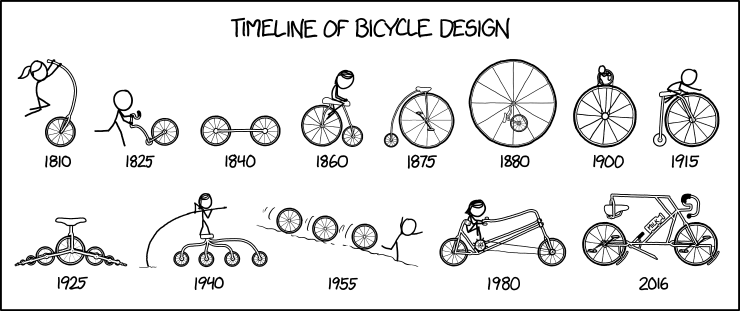 Title text: I'll be honest--the 1950s were a rough time for cycling. |
Explanation[edit]
Randall created what is supposedly a 200 year history for bicycles with 13 designs ranging from 1810 to 2016. However, a cursory glance at each one shows that they are almost all fictitious, heavily flawed, and most don't even fit the definition of "bicycle". The main point of the comic is to show off these silly joke designs.
The only model that both looks like a real model and fits the year is the 1875 model, which resembles the Penny-farthing. The Penny-farthing was popular in the 1870s until the Safety bicycle took over around 1880. The 1875 model appears to be missing handlebars, but it's worth noting that on the real bicycle, the handlebars were very small and close to the saddle, and may be too small to appear in the drawing.
The 1860 model looks like the American Star Bicycle, but that bicycle was first invented in the 1880s.
The 1900 model looks like one of Paul Scheerbart's perpetual motion machines.
Some of the other examples of "bikes" could, however, look like those in the image at the top of the Velocipede Wikipedia page.
Several of the "bikes" are shown with a human — Ponytail is "riding" the pole-vaulting bike, Cueball appears in four designs, and Megan appears in three. These humans provide a sense of scale and, in some cases, a demonstration of how the bike might be operated. Cueball's appearance in the 1900 design shows how huge that bike is, appearing to dwarf the previous two models while continuing the short trend of ever-increasing size.
Only two of the bikes have pedals (1875 and 2016) and another two have a sprocket with a chain (1900 and 1980). Seven designs include a seat for the rider — eight if you count the device holding Megan in the 1980 model.
The 1925 model is reminiscent of a fractal; Benoit Mandelbrot was born in October 1924.
The 1880 model could be the result of an evolutionary algorithm trying to produce a bicycle. Some sub-optimal algorithms that have been given the task of creating a vehicle have been shown to misplace parts in ways that makes them completely useless and/or inaccessible — for example, placing a small wheel inside a much larger wheel.
This comic (especially the 2016 bicycle) is possibly also a reference to The Science of Cycology, a cognitive psychology project run by Rebecca Lawson at the University of Liverpool, which asked study participants to draw a bicycle from memory. The error rate was high, supporting a hypothesis that humans over-estimate their ability to explain how things work. Gianluca Gimini ran a similar project, Velocipedia, in which he asked people to draw free-hand sketches of bicycles from memory, then later rendered some of the results as if they were real bikes.
Also, the designs given for the years from 1825 to 1925 distinctly resemble designs that tend to evolve in the various challenge environments in the genetic evolution games BoxCar2D (Flash Player) or Genetic Cars 2 (HTML5).
The 1980 design looks strikingly similar to the South Park "wild whacky action bike".
The title text refers to the scene labeled "1955" which depicts Cueball being chased by 3 bicycle wheels. Whatever caused the wheels to chase Cueball down a hill is left to the reader's imagination. It could be that the wheels have become sentient and are actively chasing Cueball, or it could be that the bicycle failed horribly and Cueball is running from the wreckage. The era this "bike design" is from (1955, which is in the 50s) would be hard to ride a bike in if it was the only available design.
Bike Design Analysis[edit]
| Year | Image | Description | Similar to | What's wrong with it? |
|---|---|---|---|---|
| 1810 | 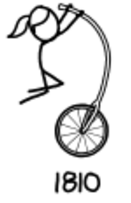
|
A single wheel with a long curved bar. Ponytail is riding it like a pole vault. | Unicycle, Pole vault | There is no means to propel it once started, since the rider is held off the ground. It would be very difficult to balance on this device as well. |
| 1825 | 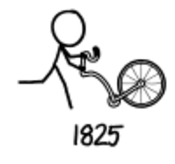
|
A large wheel connected to a tiny one, with a complex bar leading to a set of handlebars. Cueball is pushing it from behind. | Wheelbarrow | This bike has no seat and no means of propulsion other than being pushed from behind, defeating its purpose as a vehicle. |
| 1840 | 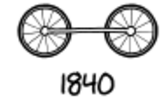
|
Two wheels connected by a single horizontal bar. | Skateboard | No means of propulsion or steering. Design is bottom-heavy, making it very difficult to keep balance. The wheels also seem to be welded to the bike, rendering it completely useless. |
| 1860 | 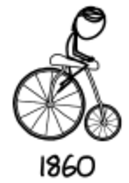
|
A large wheel in back and a small wheel in front, connected to a large seat on top. Megan is sitting on the seat doing nothing. | Pennyfarthing (backwards),American Star bicycle | No means of propulsion or steering. |
| 1875 | 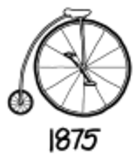
|
A large wheel in front with pedals attached, connected by a nearly-vertical rod to a small seat on top. A curved rod connects the seat to a much smaller wheel. | Pennyfarthing (almost exact match) | No handlebars are depicted, suggesting that there is no means of steering. |
| 1880 | 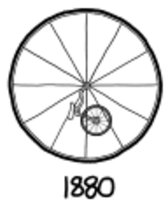
|
A very large wheel, connected by a short rod to a much smaller wheel and a seat. These hang from the axle at an odd angle. | Unicycle (vague) | The seat and small wheel appear to hang inside or next to the large wheel. A rider could not sit on the seat and would be unable to touch the ground, making it impossible to propel or control the bike. |
| 1900 | 
|
An extremely large wheel, connected by a chain to a roughly human-sized wheel on top. Cueball may be standing on it, but it's unclear what he's doing. He appears to be pushing a giant ball or a very big globe. | Unicycle | No means of steering, unclear means of propulsion. It would be very difficult to mount this device, to get it moving with human power, and to control and stop it. Additionally, it would require many resources to build and a building several stories tall to store it. |
| 1915 | 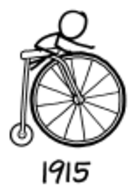
|
A large wheel connected by an angled rod to a seat. The seat is connected by a nearly-vertical rod to an extremely small wheel behind the large one. Cueball is sitting on the seat, leaning far forward and apparently turning the large wheel by hand. | Pennyfarthing, Wheelchair | No apparent means of steering. Propulsion appears to be by hand, similar to a manual wheelchair, making the device both impractical and uncomfortable. |
| 1925 | 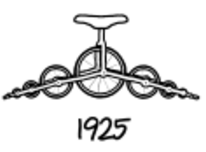
|
A symmetric seat sits atop a vertical rod connected to a wheel. From the center of this wheel, the frame extends out both front and back toward the ground, with progressively smaller wheels attached in a fractal design. It appears that only the wheels at the very ends of the rods touch the ground. | Unicycle, Fractal, Holman Locomotive | No means of propulsion or steering other than pushing against the ground. Only the tiniest wheels touch the ground - if these are truly in fractal pattern, they would not withstand the weight of a rider nor be able to roll on anything but the smoothest of surfaces. |
| 1940 | 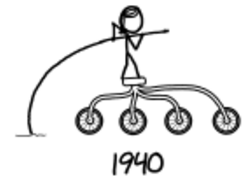
|
A single seat is connected to four small wheels in a line. Each rod is separate, and the wheels are not directly attached to one another. Megan is standing on the seat and pushing the device forward with a long, flexible pole. | Inline skates, Gondola | No means of steering or propulsion (using a pole doesn't count). Frame would very likely collapse under a rider's weight. |
| 1955 | 
|
Cueball is being chased down a hill by three bicycle wheels. | n/a | This scene suggests a spectacular failure of one or more bicycles, resulting in three wheels rolling down a hill. It's also possible the wheels became sentient and are rebelling against humans. |
| 1980 | 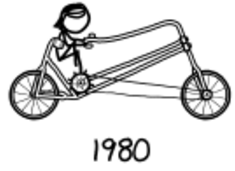
|
A wheel is connected to a triangular frame. Extending up from the frame appears to be a back rest. Just in front of the triangle is a sprocket with no pedals. Two long bars connect from here to a front bar, which extends down to a second wheel and up to a very long set of handlebars. The sprocket connects to the front wheel. Megan is crouched on top of the sprocket with her back resting against the rear frame. | "Chopper" Motorcycle, Women's Safety bicycle | No apparent means of propulsion unless the sprocket acts like a cog wheel, requiring the rider to essentially run in place to propel the bike, which would be difficult and uncomfortable in Megan's position. While this is the first of the designs that shows a clear means of steering, the chain would interfere. |
| 2016 | 
|
A rear wheel has pedals directly attached to it, and is connected to a horizontal rod. A small fender is attached to this rod under the wheel and almost against the ground. A kickstand hangs down and forward. A triangular frame extends upward toward the front, holding a milk bottle, and a second triangle connects to the front wheel, which also has pedals and a low-hanging fender. A set of touring-style handlebars is attached to the front. Two bars extend backward from the two triangles, and a horizontal bar extends backward. Just above the rear wheel, a seat is suspended inside a forked frame hanging down from the top bar. | Safety bicycle | The frame is over-complicated and, despite several strong supports in the front, would still likely collapse under a rider's weight. Front pedals would be nearly impossible to use. Seat cannot be used. Fenders and kickstand could easily strike the ground and interfere with the bike's movement. |
Transcript[edit]
- [13 drawings 8 in the top and 5 in the bottom row of different and weird "bicycle" designs. Above them there is a heading, and below each bike a year is given. On the very last cycle there is a drinking bottle with a label.]
- Timeline of Bicycle Design
- [Ponytail hanging on to a bending rod that goes down to a single normal sized bike wheel. It looks like a unicycle with no seat. The rod is bending quite a lot so she looks like she is about to use the contraption as a pole vault]
- 1810
- [Cueball is running after a device holding on to a rod bend in several places before reaching the ground at a very small wheel that then is connected with a shorter rod to a normal sized bike wheel.]
- 1825
- [Two normal sized bike wheels connected with a single rod between them.]
- 1840
- [Megan sits on a large saddle on top of a double sized bike wheel, she has some kind of handle bars to hold on to (or it could just be the saddle) and then a small rod goes down to a half size front wheel.]
- 1860
- [A regular drawing of a Penny-farthing with very small back wheel (half the size of the front wheel on the 1860 bike) and very large front wheel (larger than the 1860 bike) and pedals in the middle of the front wheel. There are no visible handlebars.]
- 1875
- [A huge wheel twice the size of the one on the Penny-farthing, and then a small wheel (like the small one on the Penny-farthing) hangs in a rod from the center of the giant wheel. The small wheel has a saddle attached, but it is not straight up.]
- 1880
- [This is the largest bike. Not the largest drawings, but where the other have the characters in roughly the same size, this one has a small drawing of Cueball standing on top of the wheel holding on to some kind of handle bar. The wheel is about three times his height.]
- 1900
- [Cueball sits in the "saddle" of a bike design that is similar to the Penny-farthing, but the saddle is more a rod, and the back wheel is on a rod going straight down from where the saddle ends. Also there are no pedals, so Cueball seems to be directly spinning the front wheel by hand.]
- 1915
- [A symmetrical saddle sits on top of single bike wheel, as with a unicycle but with no pedals. There are (at least) six progressively smaller wheels in-line to the first, three to front and three to the rear, each new wheel approximately half the size of the one before. A possible fourth wheel, presumed to complete the set of medial stabilisers, can no longer be discerned from the rod that goes through the center of the larger wheels.]
- 1925
- [Megan stands on top of a saddle that has four individual rods extending from it, each to a small wheel. One wheel is directly beneath her, one is behind her, one is the same distance in front, and one is farther out in front. Megan is pushing the bike with a long flexible rod resembling a pole vault.]
- 1940
- [Cueball is running down a steep hill with his arms up, being chased by three normal-sized bike wheels.]
- 1955
- [Megan sits on a bike contraption that seems to have a holder around her mid section rather than her sitting on a saddle. This holder goes to the back wheel below her, and there is actually a sprocket with a chain, although no clear pedals beneath her feet. She holds on to a very long handle bar, which connects with two long rods coming from the sprocket at the front end of the bike far ahead of Megan, below which is a wheel, to where the chain is actually going. Both wheels seem to be normal size.]
- 1980
- [Another weird contraption of a bike with pedals on both normal sized wheels which have handlebars on the side pointing down towards the front. The saddle hangs in a swing, connected to a rod above it, which goes to the front of the bike and splits in two rods which connect to the center frame of the bike. In front of these there is a contraption resembling many styles of touring bike handlebars, which sits just above the front wheel. The two wheels are connected with a long rod between the center of the wheels and in the middle of this is the center part of the frame going up toward the handle. On the middle of this is a bottle with a label. Towards the back wheel there are two rods sticking out, one presumably a kickstand, the other possibly a parking brake.]
- 2016
- Bottle: Milk
Discussion
I have deleted the entire paragraph with the Alternatively, explanation that this could be an analogue to the process of meiosis and pregnancy... It seems extremely far fetched to me... Kynde (talk) 13:01, 27 April 2016 (UTC)
Seconded. This is a bizarre comic, and there will be a bizarre explanation, but that is clearly not it. 141.101.70.181 13:04, 27 April 2016 (UTC)
That 1860 bike looks like the American Star Bicycle, but the year doesn't match. 141.101.79.49 13:10, 27 April 2016 (UTC)
(Moved here from explanation:)
The randomness of the designs reminds me of the strange designs produced by the genetic evolution AI in the game BoxCar2D.141.101.80.78 15:05, 27 April 2016
This comic strongly remind me of http://boxcar2d.com/ Dorus (talk) 14:24, 27 April 2016 (UTC)
I third the above comments. It could also help explain the title text, as the 1955 panel shows a broken and failed cycle, which can happen when a detrimental mutation (like weak wheel linkages) is selected by the AI to be passed on. 173.245.54.52 (talk) (please sign your comments with ~~~~)
Would have seconded it, only looks like I'm fourthing it, instead. Also I adjusted 1925's transcript description as the numbers were wrong. (I also suspect it's related to the stabilisation applied to the Pentacycle, only without visible in/out-of-page stability. (Because the third dimension doesn't exist? Well apart from 1900 that looks to be a bicycle version of the Rudge, with a solid insert to the spoked wheel ('poor man's disc-wheel' kit?) obscuring all but the spurious over-wheel drive-chain and the rider's head.) 141.101.98.137 15:09, 27 April 2016 (UTC)
Can you include the 'Alternatively,' explanation down here so I (and presumably others) don't have to wade through the page's history? We could list all sorts of far-fetched explanations, it has definitely happened on other comics. 108.162.242.135 (talk) (please sign your comments with ~~~~)
I have a feeling that this is related to the idea that nobody can draw a bicycle. For example, this artist created 3D renderings of bicycles drawn by strangers. Rael (talk) 14:51, 27 April 2016 (UTC)
- I'm not certain there's a relation, unless it's Randall pointing out that it's rather difficult for him to draw a bicycle while maintaining a simple stick-figure theme? Regarding that guy's experience asking strangers to draw a bicycle: Most people do not draw very well. At all... Many people can't even draw faces very well & we look at faces *all the time*. We're predisposed to spot faces even when they're not there, yet most people get the proportions wrong. I'm not sure why he was surprised that most people couldn't draw a mechanically accurate representation. Bicycles are moderately complex machines that many people feel overwhelmed by, to the point of omitting otherwise advantageous equipment, such as multiple gears. 141.101.98.25 (talk) (please sign your comments with ~~~~)
- Well, as you could see, most of the people who tried to draw bicycles were able to at least sketch something that resembled a bicycle. You don't have to be an artist to get the basic idea down. The thing I found more interesting was that many of the drawings were just plain wrong (e.g. the chain going all the way between the front and back wheels) or lacked significant parts. In some cases, it's clear that the drawer just overlooked one or two things - easy to do - and in other cases, it shows that the person actually had difficulty recalling the basic structure of a bicycle. Everyone who participated clearly knows what a bike is and, from a practical standpoint, how it works. But from a brain-sciences perspective, there's a difference between the symbolic memory of a bicycle (I know what it is and how to use it, and I can remember what color mine is, etc.) and detailed visual memory (I know all the parts and can reconstruct them visually). That's what's being exposed in that experiment. :)
- That said, I agree that I don't think there's a strong relation between this comic and that experiment. I think it's more likely that Randall is poking fun at both genetic algorithms (perhaps self-learning AIs) and design prototyping (throw a bunch of stuff at the wall and see what sticks). KieferSkunk (talk) 16:56, 29 April 2016 (UTC)
Does anyone else think the 1980 bike resembles a horse-drawn carriage minus the horses? Specifically, the two long parts Megan is holding look like reins. 108.162.246.122 16:06, 27 April 2016 (UTC)
- This one rather makes me think of a chopper, only without the engine. 108.162.229.49 16:49, 27 April 2016 (UTC)
- Indeed, there is a movement for both chopper and lowrider bicycles. I have seen both and the 1980's bicycle looks almost like a lowrider bike I saw in Arvada CO probably in 2014. 162.158.255.89 17:29, 27 April 2016 (UTC)
The 1980 design is reminiscent of long-wheelbase recumbent bicycles, which were originally designed in the 1930s and enjoyed a resurgence starting in the later 20th century. An Iowa company produced a bicycle called a 'Linear' about this time which did have extremely long handlebars; steering it was more like using a tiller on a boat. The fallacy here is using a chaindrive to power the (steerable) front wheel; this simply would not work. RAGBRAIvet (talk) 20:18, 28 April 2016 (UTC)
- actually, chain drive to the front wheel would work fine. You would have to fix the front wheel rigidly to the frame, of course, which means the rear wheel must do the steering. It seems possible the odd structure holding the rider (Megan) is intended to let her steer the rear wheel by twisting her body. 108.162.212.50 (talk) (please sign your comments with ~~~~)
I came here thinking I did not get the joke. After reading the description I see I am not the only one. 108.162.246.119 16:23, 27 April 2016 (UTC)
- Same here. I think the joke is just Randall exaggerating actual bicycle designs. Either that or it's "The Evolution of the Bicycle" in an alternate reality. 173.245.52.62 17:30, 27 April 2016 (UTC)
Is the point of the timeseries that while most things in biology evolve gradually over time (think all of those Evolution of Man t-shirts), undergoing great changes in form, we basically hit all the possible bicycle designs in the first 20 years and it has gone along essentially unchanged ever since? There are specialty bikes made possible by new frame materials, but they are all "Safety Bicycles". The takeaway of the comic could be either about the simplicity of the solution to the bicycle "problem", or about the difference between engineered design and the natural selection. Peregrinus (talk) 17:27, 27 April 2016 (UTC)
The 1955 design reminds me of the movie "Rubber". http://www.imdb.com/title/tt1612774/ Is that too tenuous of a connection? ChrisPwildcat (talk) 19:11, 27 April 2016 (UTC)
- I definitely made the same connection. (Wow, the scene where the tire stares into its own reflection & remembers all of its actions so far... I felt empathy for that tire. WTH?) The 1955 design definitely implies that the wheels are trying to kill Cueball. 141.101.98.25 (talk) (please sign your comments with ~~~~)
- Perhaps you are feeling sorry for the 1955 tires. That is because you are crazy. The 1980 design is much better. </ikea> :) KieferSkunk (talk) 14:38, 29 April 2016 (UTC)
This reminds me of certain videos I watched about evolution, in sequence, the picutres could be describe various models (some of them apparently unfit, thus discontinued) of bicycles as if they were derived from the laws that govern evolution (random mutation and natural selection). 198.41.243.242 21:42, 27 April 2016 (UTC)
Could the 1955 design be backwards cheese rolling? 173.245.54.44 21:54, 27 April 2016 (UTC)
(Re: 1955) "This is obviously the most ridiculous of all of these designs" - clearly, someone has really badly misspelt the word "awesome" here. Please fix. 141.101.98.92 08:12, 28 April 2016 (UTC)
- And the text I quoted is no longer in the article. Muahahaha, the power of the talk page! 141.101.98.92 15:58, 28 April 2016 (UTC)
Someone using the 2016 bicycle wouldn't be very welcome in Skyrim (milkdrinkers...) 108.162.219.79 14:36, 28 April 2016 (UTC)
This could be an example of a (badly parameter-ed) genetic algorithm. 108.162.237.244 (talk) (please sign your comments with ~~~~)
I added a table describing each bicycle design (not copied from the transcript), naming things the design is similar to (e.g. unicycles, Pennyfarthings, etc.), and what's wrong with it. :) KieferSkunk (talk) 14:36, 29 April 2016 (UTC)
1940 bicycle: Megan looks as if she is propelling her bike like a Venetian gondola.These Are Not The Comments You Are Looking For (talk)
Could this be related to either UI design philosophies or business process design ideas that prevailed in those eras? 162.158.255.18 20:00, 19 May 2016 (UTC)
- Categories
Quick question: I noticed this explanation is included in "Category:Multiple Cueballs". Is this correct? It stands to reason that we may just have the same Cueball appearing in multiple photos as he attempts to demonstrate how to use each bike design. If we do consider this an instance of multiple Cueballs, should we also have a category for multiple Megans, since she appears three times as well? KieferSkunk (talk) 17:17, 29 April 2016 (UTC)
I'm almost certain he is making fun of https://vimeo.com/73581450 173.245.54.47 (talk) (please sign your comments with ~~~~)
In my honest opinion, it is a reference to https://www.youtube.com/watch?v=GOFws_hhZs8 162.158.196.191 00:09, 2 May 2016 (UTC)GianniPiccioni
Could the 1940 design resemble a tank? It was the beginning of WWII. 141.101.70.151 (talk) (please sign your comments with ~~~~)
Regarding the explanation of the 1900's design: "... but it's unclear what he's doing.": Imho it's not unclear but quite obvious that Cueball's operating the device with somthing like this: http://thumbs.dreamstime.com/z/industrial-wheel-valve-handle-vintage-rusty-equipment-machine-part-40567595.jpg What do you think? Elektrizikekswerk (talk) 12:37, 2 May 2016 (UTC)
- And for the 1940's design: Why does using a pole not count for propulsion and steering? https://en.wikipedia.org/wiki/Punt_%28boat%29 Elektrizikekswerk (talk) 12:49, 2 May 2016 (UTC)
- I'm honestly not sure how you can make out what Cueball is doing on the 1900 bike - do you have access to a higher-resolution image than I do? Even zooming in on the one in the comic, I can only make out that Cueball is standing on the thing, but otherwise not determine what he's doing. As for the 1940 design: Pushing the pole against the ground is a means of external propulsion - as in, the bike has no way to be propelled within itself (pedals, etc.). Using the pole on the ground is in the same vein as pushing a wheelbarrow from behind - the only difference is that the person pushing the pole is on the bike, and so you can still call it a vehicle. KieferSkunk (talk) 19:51, 3 May 2016 (UTC)
- Maybe my mind is just filling the gaps, but I derive it from Cueball's posture. But indeed, I cannot actually see what he's doing. Maybe we could agree on something like "Due to low resolution it's not perfectly clear what he's doing, but presumably the upper wheel might be something like a big crank wheel Cueball's operating"? For the 1940's: To be honest I don't see why this should be called "external" (and therefore being invalid as propulsion at all?). The wheelbarrow on the other hand is external. Why? The 1940's design is - from a propulsion point of view - the same as a rowboat, while the wheelbarrow is a sailboat. Or if you get more modern: The 1940's design is a normal rocket while the wheelbarrow is this: https://en.wikipedia.org/wiki/Beam-powered_propulsion. But that's not my point. I simply want to know what's making using a pole invalid in regard to being a means of propulsion at all. Elektrizikekswerk (talk) 07:17, 4 May 2016 (UTC)
Someone keeps insisting that Megan appears 4 times and Cueball only 3, and at one point they specifically said it was Megan on the 1900 bike. I'm pretty sure it's Cueball on the 1900 bike, so he would appear in 1825, 1900, 1915 and 1955, with Megan showing up in 1860, 1940 and 1980. Does anyone see differently here? KieferSkunk (talk) 20:09, 3 May 2016 (UTC)
- Agree. 3 Megan, 4 Cueball (and 1 Ponytail) Elektrizikekswerk (talk) 07:17, 4 May 2016 (UTC)
On the 1925 bicycle, I don't think it's just the wheels at the ends that touch the ground; it seems like all of them do. A reason for the wheels at the end to be farther down could just be because of the way Randall accidentally drew them; when I draw fractals like that, it's hard to keep the tiniest bits in line with the rest because of how small they would have to be (don't know if that makes sense at all). 172.68.142.179 19:02, 6 February 2019 (UTC)
Somebody replaced the entire article with “crap crap crap crap”
